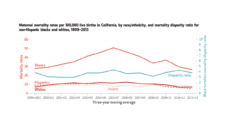When we talk about maternal mortality in the US, we assume women are dying of birth trauma or inadequate postnatal care. According to the National Center of Health Statistics (NCHS), a maternal death is “the death of a woman while pregnant or within 42 days of termination of pregnancy.” The NCHS excludes deaths from causes that are not considered pregnancy-related. For example, if a pregnant woman dies in a car accident, she would not count as a maternal death. Likewise, homicides do not count as maternal deaths. But mounting evidence suggests they should.
A research team headed by Maeve Wallace recently examined the cause of death of every person who died during pregnancy or up to a year postpartum in Louisiana. Dr. Wallace’s team included all causes of death, including the “incidental” deaths the NCHS leaves out. The researchers found that the most common medical causes of perinatal death were hypertension and obstetric embolisms. Shockingly, maternal deaths from homicide occurred at more than three times the rate of hypertension or embolisms.
Women of reproductive age in Louisiana were twice as likely to die by homicide during pregnancy than when not pregnant. Most homicides during pregnancy are committed by a romantic or sexual partner. More broadly, intimate partner violence (IPV) during pregnancy is common.
Pregnancy and the postpartum period are times of increased risk for homicide, so homicides are pregnancy-related deaths and should be counted towards maternal mortality rates.
According to the NCHS definition, the maternal mortality rate in the US is 17.4 deaths per 100,000 live births. The US ranks 55th in maternal mortality worldwide and last among similarly wealthy countries. If homicides counted as maternal deaths, US maternal mortality would be even worse compared to other countries. Homicide rate in the US is almost eight times higher than in peer countries.
Using the current metric, non-Hispanic Black women die at up to three times the rate White and Hispanic women do. Additionally, non-Hispanic Black women in the US are two times more likely to experience IPV than their White, Asian, or Hispanic peers. Black women who experience IPV are also less likely to access mental health services or medical attention than White women. There is little national data on how maternal homicide varies by race, but given racial disparities in IPV and access to care afterwards, current maternal mortality statistics likely underestimate racial disparities in maternal mortality.
Pregnancy and the postpartum period are times of increased risk for homicide, so homicides are pregnancy-related deaths and should be counted towards maternal mortality rates. By counting homicides as maternal deaths, we might see that maternal mortality in the US is even worse than the current disturbing statistics indicate.
Photo via Getty Images














